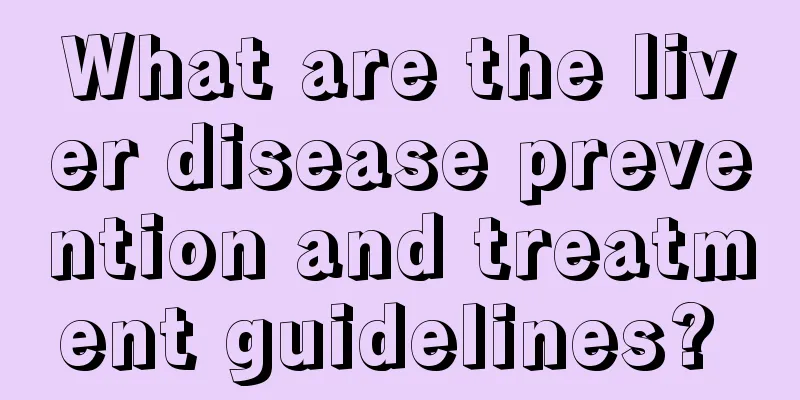What are the liver disease prevention and treatment guidelines?

|
The liver is a very important organ in the human body. If there is a problem with the function of this organ, the body's detoxification ability will be greatly reduced. In severe cases, toxins will appear in the body, such as some heavy metal poisoning. The human liver will have many kinds of diseases, such as hepatitis, cirrhosis and fatty liver, etc. These diseases are very harmful, so we should take measures to prevent and treat liver disease. The following is a guide to the prevention and treatment of liver disease. Liver disease prevention and treatment guidelines: (1) HCC surveillance should be performed in patients with cirrhosis because it can improve overall survival. (Quality of evidence: moderate; Strength of recommendation: strong) (2) Ultrasound (US) monitoring is performed every 6 months, and there is no strict requirement for alpha-fetoprotein (AFP) monitoring. (Evidence quality: low; Recommendation strength: conditional) (3) Patients with Child-Pugh C liver function cirrhosis have a low expected survival rate, so it is recommended that patients who are not awaiting transplantation do not need to be monitored. (Evidence quality: low; Recommendation strength: conditional) Technical Review (1) It is still unclear which monitoring method can better improve the survival rate, US alone or combined US+AFP testing. (2) The optimal monitoring interval is 4 to 8 months. (3) No new surveillance strategies based on etiology or risk stratification models are currently recommended. The old guidelines summarized people with chronic hepatitis B and cirrhosis, but did not include people with cirrhosis caused by chronic hepatitis C or fatty liver. Whether monitoring biomarkers such as AFP improves survival is uncertain. Should adult patients with cirrhosis and suspected HCC undergo diagnostic evaluation with CT or MRI? Recommendations HCC can be diagnosed using either CT or MRI, with similar diagnostic accuracy. (Evidence quality: lower for CT than for MRI; Recommendation strength: strong) Technical Review (1) In addition to considering the accuracy of diagnosis, it is also necessary to consider the conditions of the medical institution, the doctor's technical ability, the time spent on the examination, the cost, safety, and the patient's personal factors. (2) MRI is more technically complex than CT. Without professional knowledge, it is not recommended to use MRI examinations universally. Unlike most other malignancies, imaging diagnosis of HCC is relatively reliable, but there is no consensus on which imaging diagnostic technique to use. The recommended contrast agent is a gadium-based compound: disodium ganodeoxynate. When the nature of liver nodules in patients with cirrhosis is uncertain, should biopsy, repeated imaging examinations, or multiple imaging examinations be used? Recommendations (1) There are many options for liver nodules of uncertain nature, including follow-up imaging examinations, the use of other contrast agents or alternative imaging examination methods, and biopsy, but it is impossible to recommend which method is better. (Evidence quality: very low; Recommendation strength: conditional) (2) Routine biopsy of every liver nodule of unclear nature is not recommended. (Evidence quality: very low; Recommendation strength: conditional) Technical Review (1) Biopsy may provide a timely diagnosis and thus influence treatment decisions, but it carries the risk of bleeding and tumor implantation. A negative test result may be due to failure to obtain representative tissue. (2) According to the Liver Imaging Reporting and Data System (LI-RADS) of the American College of Radiology, the Organ Procurement and Transplantation Network (OPTN), and previous AASLD guidelines, strict imaging criteria have been established for HCC with a diameter ≥1 cm. The typical manifestations are significant enhancement in the arterial phase, less enhancement than that of the surrounding liver tissue in the venous phase, and continuous regression in the delayed phase. However, it is not applicable to lesions smaller than 1 cm. AASLD has recommended biopsy under US surveillance in the past, but biopsy has various limitations and is not the best strategy for all cases. There is controversy over how best to manage an undefined liver nodule. |
<<: Is placenta storage useful?
>>: Can pregnant women eat sweet potatoes?
Recommend
New skin cancer suppressor gene discovered
Researchers at the National Institutes of Health ...
What are the effects of Jigeng
Many people may not pay much attention to the pha...
What medicine is better for insufficient gastric motility
The general way to relieve gastric motility defic...
The hazards of post-loading radiotherapy for cervical cancer
Cervical cancer is one of the common malignant tu...
What is the reason for itchy pain in the soles of feet
Many people often feel itchy or even painful in t...
10 early symptoms of pancreatic cancer
Pancreatic cancer is a highly lethal malignant tu...
What are the precautions for all-femtosecond laser treatment?
LASIK is an advanced corneal refractive surgery. ...
Where is the best brain cancer hospital
In recent years, the incidence of various types o...
What causes pain in the kidney area? Is it related to kidney disease?
At present, more and more patients are diagnosed ...
How to pick and wash Chinese toon
Spring is the time when Chinese toon starts to be...
What is potassium salt
Potash salt is a relatively special salt that mai...
Can nasopharyngeal cancer be cured without surgery?
After diagnosing nasopharyngeal cancer, we need t...
Can coix seed be soaked in water with oatmeal to drink
If you eat raw coix seed kernels, it is likely to...
Losing sense of smell after catching a cold
Everyone may have had this feeling: after catchin...
How to prevent the recurrence of lung cancer 4 good ways to prevent the recurrence of lung cancer
There is a kind of pain that the disease relapses...









